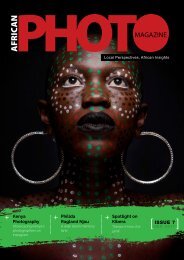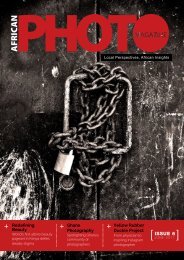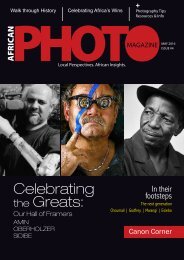African Photo Magazine Issue #8
We are particularly delighted to publish, in this issue, photographers showcasing studio photography talent that echoes the work of one of Africa’s greats, Malick Sidibé (1936–2016). Photographers Hassan Hajjaj, Omar Diop and Samuel Fosso have stayed true to the photographic style that made Mr Sidibé’s work legendary. The portraitures are uniquely stylish and follow signature themes that clearly identify each photographers artistic bent. The work of this trio speaks to the heart of this publication, the genesis of which was to not only celebrate contemporary African photography but to reach back and illuminate the artistry and creativity of our forefathers and those that came before us, and to never forget that we stand on the shoulders of giants.
We are particularly delighted to publish, in this issue, photographers showcasing studio photography talent that echoes the work of one of Africa’s greats, Malick Sidibé (1936–2016). Photographers Hassan Hajjaj, Omar Diop and Samuel Fosso have stayed true to the photographic style that made Mr Sidibé’s work legendary. The portraitures are uniquely stylish and follow signature themes that clearly identify each photographers artistic bent. The work of this trio speaks to the heart of this publication, the genesis of which was to not only celebrate contemporary African photography but to reach back and illuminate the artistry and creativity of our forefathers and those that came before us, and to never forget that we stand on the shoulders of giants.
You also want an ePaper? Increase the reach of your titles
YUMPU automatically turns print PDFs into web optimized ePapers that Google loves.
In the 70s she was a source of inspiration to<br />
many young people, some of whom flocked<br />
to her home after the 1976 uprising. Some<br />
went into exile, others remained and coached<br />
by her, became leaders of the United<br />
Democratic Front.<br />
Winnie was banished to a dusty village,<br />
Brandfort, hundreds of miles from her Soweto<br />
home, and that, and an incident in 1969 broke<br />
her. In 1969, security branch came to her<br />
Soweto home at 3am. She was alone with her<br />
daughters, aged 10 and nine. Winnie asked<br />
to fetch her sister one street up so the girls<br />
would not be alone. The police refused, she<br />
was taken and her children left alone.<br />
She spent 18 months in solitary confinement,<br />
naked, not allowed to wash, and not allowed<br />
out for exercises. She did not know what had<br />
become of her girls. When she would speak<br />
of this with me, her whole countenance<br />
would change. She was not allowed sanitary<br />
towels when she had periods, nor water or<br />
cloths to clean, and so the blood caked on<br />
her. She made friends with cockroaches. I’ve<br />
been in the cell at the Old Fort that she was<br />
held in. It is narrow with high, thick walls, it is<br />
oppressively dark when the door is closed, as<br />
it was for 18 months.<br />
I believe she experienced profound Post<br />
Traumatic Stress. It was never treated;<br />
instead, she was expelled to Brandfort. She<br />
had a classic four-room house with a biggish<br />
yard. Money from mostly American donors<br />
saw her build a large bedroom with a quilt on<br />
it made by American sympathisers. She used<br />
to wait at the Brandfort post office at around<br />
11am each day for phone calls, or would make<br />
phone calls out. People who visited her were<br />
arrested and charged.<br />
Winnie was isolated and lonely, it was here<br />
that the drinking and drug taking began,<br />
and affairs with younger men, including a<br />
dreadlocked filmmaker. The conservative<br />
black folk of Brandfort township grew to<br />
loathe her.<br />
Winnie Mandela in front of the house she was banished to<br />
with her daughters in 1977during her exile in Brandfort<br />
Winnie on Right waits for a glimpse of Nelson Mandela<br />
outside the Palace of Justice in Pretoria on June 1964 after<br />
his conviction of sabotage and sentence to life in prison<br />
Winnie was detained without trial for 18 months over 1969<br />
and 1970<br />
Nelson Mandela and Winnie after his release from Victor<br />
Verster prison in Western Cape in this February 11, 1990<br />
Mandela United Football Club, it became an<br />
instrument of torture and murder of young<br />
men wrongly accused of being spies. At<br />
the TRC hearings where its activities were<br />
recounted, Archbishop Desmond Tutu, who<br />
knew her long put his head on the table and<br />
cried.<br />
Mandela wrote, “I have often wondered<br />
whether any kind of commitment can ever be<br />
sufficient excuse for abandoning a young and<br />
inexperienced woman in a pitiless desert.”<br />
And so, when he came out of jail in 1990 it<br />
was with his hand in hers, even though a few<br />
Sundays before his release her explicit love<br />
letters to a young lawyer were released. On<br />
the night of his return to Soweto, she left the<br />
house in the early hours of the morning with<br />
the lawyer in full view of the world’s media<br />
camped outside.<br />
Zwelakhe Sisulu who accompanied them to<br />
the U.S.A. not long after said she would yell at<br />
Madiba in hotel rooms. The entourage were<br />
not sure how to cope with these outbursts.<br />
Archbishop Tutu revealed, “Mandela said to<br />
me that he was never so unhappy as in the<br />
period after he was released until he decided<br />
to leave Soweto.”<br />
Winnie was unrepentant, she ran up huge bills<br />
on Mandela’s tab, was convicted on multiple<br />
counts of theft and fraud, and became an<br />
embarrassment.<br />
Lots of false pieties will be said about her<br />
now. The truth is that once there was a<br />
beautiful, proud woman who studied social<br />
work with an older woman, Albertinah Sisulu.<br />
Through her she met a handsome, brilliant<br />
lawyer called Nelson Mandela. They fell in<br />
love. He divorced his first wife to marry her.<br />
They had two children. Their marriage was<br />
passionate. He adored her, I don’t believe he<br />
ever loved anyone as much. However, their<br />
life was never normal because of his political<br />
activities, which she embraced.<br />
She would get visiting international<br />
dignitaries like Senator Edward Kennedy with<br />
his large entourage in 1985, but it deepened<br />
resentment of her.<br />
When she came back to Johannesburg,<br />
in defiance of her banning order, Madiba<br />
was already in secret communications with<br />
the apartheid government. She formed the<br />
Mosiuoa Lekota, Winnie and Desmond Tutu in the front line<br />
during a Free Mandela demonstration in Cape Town 1990<br />
Nelson Mandela and Winnie on the day of their wedding<br />
in 1958<br />
When Mandela went to jail he was<br />
comparatively safe compared to the perilous<br />
life she experienced. The apartheid state<br />
punished her because of him, and too<br />
because of her; she was an effective conduit<br />
for sending young people into exile for<br />
military training.<br />
32 africanphotomagazine ISSUE 8 December 2018 33










